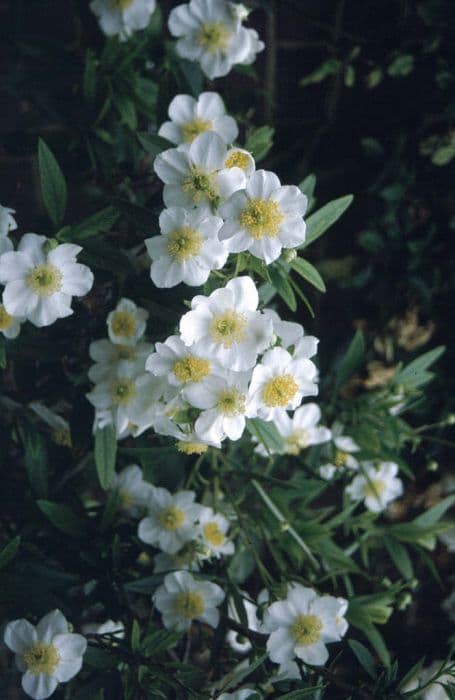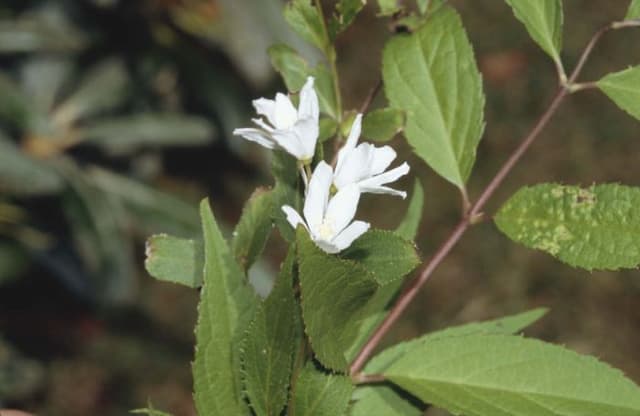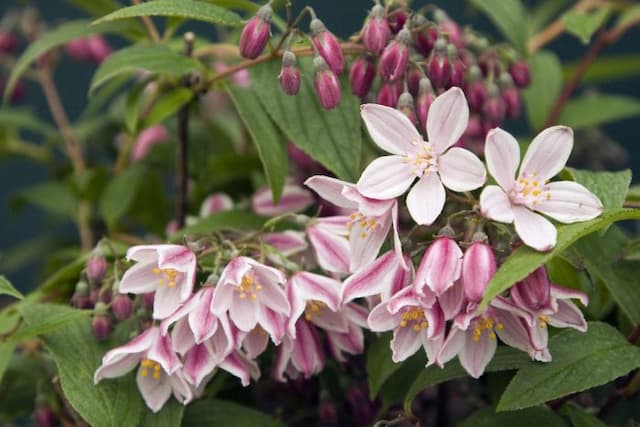Rough-leaved Hydrangea Hydrangea aspera subsp. strigosa

ABOUT
H. aspera subsp. strigosa is a variable, deciduous, slow-growing shrub, to around 3m tall, with lanceolate or narrowly-ovate leaves the undersides of which are covered with short, stiff hairs. From summer into autumn, flowerheads comprising purple fertile flowers surrounded by white sterile ray florets are borne
About this plant
 Names
NamesFamily
Hydrangeaceae
Synonyms
Rough-leaf Hydrangea, Hairy Hydrangea
Common names
Hydrangea strigosa, Hydrangea aspera var. sargentiana, Hydrangea aspera var. robusta.
 Characteristics
CharacteristicsLife cycle
Perennials
Foliage type
Deciduous
Color of leaves
Green
Flower color
Mixed
Height
10 feet (3 meters)
Spread
10 feet (3 meters)
Plant type
Shrub
Hardiness zones
7
Native area
Asia
Benefits
 General Benefits
General Benefits- Aesthetic Appeal: Hydrangea aspera subsp. strigosa, commonly known as rough hydrangea, offers ornamental value to gardens with its large, showy flowers and lush foliage.
- Habitat for Wildlife: The plant's flowers provide nectar for pollinators like bees and butterflies, while the dense foliage can offer shelter to birds and small animals.
- Erosion Control: The rough hydrangea's extensive root system can help to stabilize soil and prevent erosion on slopes or banks.
- Seasonal Interest: With its summer blooms and sometimes colorful autumn leaves, it adds seasonal interest to any landscape.
- Companion Planting: This hydrangea species can be used in mixed borders or woodland gardens, complementing other shade-loving plants.
- Low Maintenance: Once established, it typically requires minimal upkeep, apart from occasional pruning to maintain shape and encourage flowering.
 Medical Properties
Medical PropertiesThis plant is not used for medical purposes.
 Air-purifying Qualities
Air-purifying QualitiesThis plant is not specifically known for air purifying qualities.
 Other Uses
Other Uses- Hydrangea aspera subsp. strigosa, commonly known as 'Rough-leaved Hydrangea,' can be used as a natural pH indicator, given its unique property to show color variation in its flowers in response to soil pH levels.
- Extracts from the Rough-leaved Hydrangea have been traditionally used as a natural dye for fabrics, providing shades ranging from blue to pink depending on the treatment of the dye.
- The wood of Rough-leaved Hydrangea can be used in the creation of small artisanal crafts due to its fine grain and ease of carving.
- Rough-leaved Hydrangea leaves can be used in compost piles, as they decompose well and add nutrient-rich organic matter to the soil.
- When dried, the flowers of the Rough-leaved Hydrangea can be used in potpourris or as a natural air freshener due to their pleasant fragrance.
- In landscaping, Rough-leaved Hydrangea can act as a natural erosion control on slopes due to its extensive root system.
- The blooms of the Rough-leaved Hydrangea can be used as a natural confetti in outdoor celebrations, as they are biodegradable and non-toxic to the environment.
- The bark of Rough-leaved Hydrangea contains substances that can be used in the tanning process of leather, contributing to both the color and durability of the material.
- The rough textured leaves can serve as a natural abrasive for light cleaning tasks or for scrubbing delicate surfaces when a soft touch is needed.
- During the winter, the dried seed heads of Rough-leaved Hydrangea can offer food for birds and add interest to the garden when most other plants have died back.
Interesting Facts
 Feng Shui
Feng ShuiThe Rough-leaf Hydrangea is not used in Feng Shui practice.
 Zodiac Sign Compitability
Zodiac Sign CompitabilityThe Rough-leaf Hydrangea is not used in astrology practice.
 Plant Symbolism
Plant Symbolism- Heartfelt and Sincere Emotions: The lush and abundant blossoms of the hydrangea represent the overflowing of strong feelings and the ability to express deep emotions.
- Gratitude and Appreciation: Gifting hydrangeas can be a way of saying 'thank you' for understanding and support, making them a symbol of gratefulness.
- Understanding: The hydrangea's varied and complex flower formations can signify the many facets of understanding in relationships, highlighting empathy and patience.
- Vanity and Boastfulness: In some cultures, hydrangeas may also represent vanity or narcissism due to their showy and large flower heads.
- Frigidity and Heartlessness: The hydrangea might bear negative symbolism, including heartlessness or lack of empathy, based on the belief that it produces many flowers but very few seeds.
- Fourth Wedding Anniversary: Hydrangeas are often associated with the fourth wedding anniversary, symbolizing genuine emotions and growing appreciation between a married couple.
 Water
WaterThe Rough-leaf Hydrangea should be watered deeply to encourage root growth, generally every week with about 1 inch of water, amounting to approximately 0.623 gallons for an outdoor plant. During hot or dry periods, the frequency may need to increase to twice a week. Ensure the soil is moist but not waterlogged, as over-watering can lead to root rot. Mulch can help retain soil moisture. Cut back on watering during the fall to prepare the plant for winter.
 Light
LightRough-leaf Hydrangea thrives in dappled sunlight or partial shade. It is best to avoid intense afternoon sun, which can scorch the leaves. A spot with morning sunlight and afternoon shade, or filtered light beneath a canopy of trees, is ideal for this plant.
 Temperature
TemperatureRough-leaf Hydrangea prefers a temperate climate and does well in a range that falls between 60°F and 75°F. It can tolerate minimum temperatures down to about 20°F, but frost can damage the buds. During the growing season, maintain as consistent a temperature as possible within the preferred range.
 Pruning
PruningRough-leaf Hydrangea benefits from pruning to remove dead or crossing branches and to encourage a strong framework, which should be done in late winter or early spring before new growth begins. Pruning immediately after blooming can be done to shape the plant or to reduce size, though it may reduce flowers for the following season, as it blooms on old wood.
 Cleaning
CleaningAs needed
 Soil
SoilRough-leaved Hydrangea thrives in a well-draining soil mix rich in organic matter with a pH range of 5.0 to 6.5; a blend of peat, compost, and perlite is ideal.
 Repotting
RepottingRough-leaved Hydrangea should be repotted every 2-3 years to refresh the soil and accommodate root growth.
 Humidity & Misting
Humidity & MistingRough-leaved Hydrangea prefers a higher humidity level, around 60% if possible, to thrive and grow healthy leaves and flowers.
 Suitable locations
Suitable locationsIndoor
Provide bright, indirect light and keep soil moist for indoor Rough-leaved Hydrangea.
Outdoor
Plant in partial shade, mulch well, and ensure soil is moist for outdoor Rough-leaved Hydrangea.
Hardiness zone
7-9 USDA
 Life cycle
Life cycleHydrangea aspera subsp. strigosa, commonly known as Rough-leaved Hydrangea, begins its life cycle when seeds germinate in moist, well-drained soil in partial to full shade. The seedlings develop into juvenile plants with large, velvety leaves, and as they mature, they form woody stems that can grow to sizes of 10-15 feet tall and wide. During its growth stage, which occurs annually in the spring, the Rough-leaved Hydrangea develops new shoots and leaves, and in the summer, it enters the flowering stage, producing large inflorescences composed of small, fertile flowers surrounded by larger, sterile bracts. After pollination, typically by insects, the flowers develop into capsules that contain the seeds, completing the reproductive stage. In autumn, the leaves may change color before falling off as the plant enters dormancy during the winter months. Every year, as the plant emerges from dormancy in the spring, the cycle repeats with new growth, ensuring the continuation of the species.
 Propogation
PropogationPropogation time
Spring-summer
Hydrangea aspera subsp. strigosa, commonly known as rough-leaved hydrangea, can be propagated most effectively through softwood cuttings. This method is usually undertaken in the late spring or early summer when new growth is still soft and pliable. Cuttings should be about 4 to 6 inches (10 to 15 centimeters) long and include several leaf nodes. The lower leaves are removed, and the cut end is dipped in rooting hormone before being placed in a well-drained potting mix. To create a humid environment, the cutting can be covered with a plastic bag or placed in a propagator. Roots typically develop within 4 to 8 weeks, after which the new plant can be acclimated to less humid conditions and eventually transplanted outdoors.







![Hydrangea [Strong Annabelle]](/_next/image?url=https%3A%2F%2Fplants-admin.emdemapps.com%2Fimages%2Fplants%2F%2Fimages%2F604b54db37d34.png&w=640&q=75)

